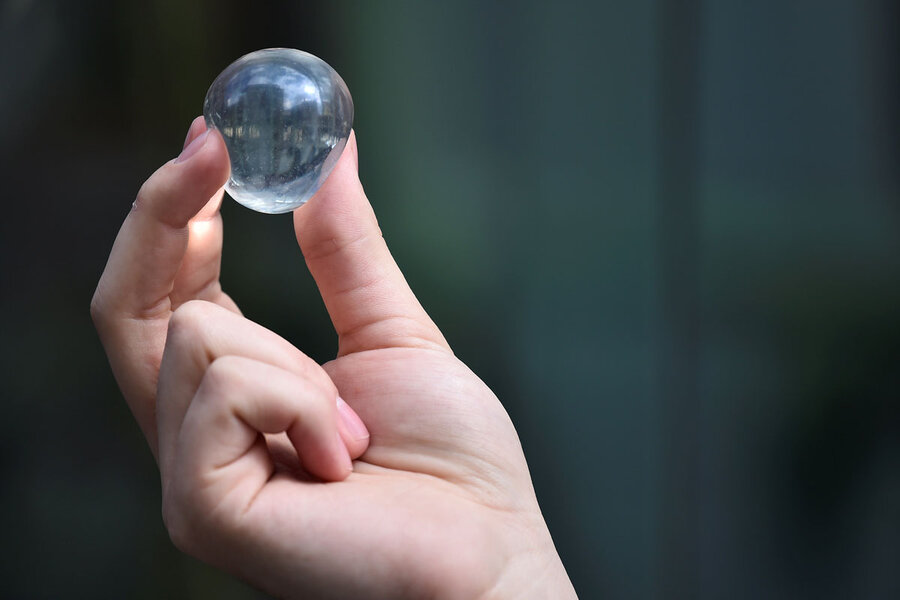Would you eat your water bottle if that would save the planet?
Loading...
How often have you drunk from a water bottle only to toss the water bottle away? A London-based startup wants to you to stay hydrated by “eating” a water balloon-like blob instead, creating no plastic waste.
The blob, named “Ooho,” is a seaweed-based, double-membrane capsule containing water. While the idea of having biodegradable wrapping is not new, recent innovations have been emphasizing the “edible” aspect to appeal to environmentally conscious consumers keen on solving the problem of mountains of waste that are clogging the Earth's oceans and waterways and taking up valuable space in landfills. With an edible water bottler, for instance, consumers can experience the immediate satisfaction of doing their part to reduce waste – a step beyond tossing recyclables into a bin and hoping they end up where they are supposed to.
“I think a lot of the issue with sustainability and being greener is that it leaves the consumer out of the experience,” says Sean Coary, a consumer behavior expert at St. Joseph’s University in Philadelphia, Penn., in an interview with The Christian Science Monitor. “If you buy a plastic bottle that is made of 30 percent less plastic, you really don't experience your contribution to a greener society, whereas if you 'eat' your water bottle, you're actually reminding yourself and consciously thinking of this step that you're taking to be sustainable, to be greener, and that could have a more positive impact on the consumer.”
And without the need to open something or throw the container away after consumption edible packaging also gains another advantage: convenience.
Ooho, developed by Skipping Rocks Labs, a London startup, can be consumed either by eating it as a whole or peeling off the outside membrane and piercing the inner membrane – both of which will decompose within four to six weeks. While only 2,000 are being produced each day, the company describes it as “the most sustainable disposable alternative to plastic bottled water on the market” that could tackle a growing plastic waste problem. In the United States alone, Americans drink 12.8 billion gallons of bottled water a year.
While the blobs of liquid have attracted attention and curiosity at the startup’s various sampling events across London, the concept of edible food packaging isn't necessarily new. In some cases, edible food wrappings have been so accepted by mainstream consumers no one ever gives them a second thought, such as the ubiquitous ice cream cone or a popular Japanese candy that comes wrapped in edible rice paper. They also occur in nature, such as orange peels that can be dipped in chocolate or potato skins that can be baked into a delicious treat.
“I mean there has always been this notion of ... something around the [food] product that is edible,” says Bernd Schmitt, a marketing professor at Columbia Business School in New York City.
Yet there seems to be a limit to what kinds of manufactured materials consumers are willing eat, some experts say, creating a challenge for edible food packaging to achieve success at a mass scale. After all, would you want to eat your paper plate after you cleaned it?
But scientists are banking on the hope that as more consumers become concerned about the future of the planet and more aware of their own lasting footprint on the environment, they will continue to open up to new products. These include the “WikiFoods” (previously “Wikipearls”) started by Harvard University scientist David Edwards, which contains various foods and beverages in edible packages made of natural ingredients like the skin of a grape. With frozen vanilla in the core and real fruits such as cherry, blueberry, or caramel as the outside layer, a current version of WikiFoods looks like bite-sized treats that the company says combine nutrition with sustainability. Other edible containers, such as edible cups and edible wrappers, are also in the works.
But mass-market adoption is not likely to happen any time soon.
“Consumers are always lazy,” Schmitt explains. “They are not easily adopting innovations,” especially when it comes to food.
However, Elizabeth Minton, an expert in pro-social marketing from the University of Wyoming in Laramie, Wyo., says sustainable innovations like edible water bottles could easily build up following – if consumers are given a chance to try it out at events like athletic events or summer concerts.
“With a lot of these really new products, if you can get it involved in some kind of event-based marketing that is already using your product, you can get it to big audience,” says Ms. Minton.
But even exposure at large events can't promise the new products will ever be seen as something more than a passing gimmick. Remember Dippin' Dots – the so-called "ice cream of the future"? The nitrogen frozen pellets remain a novelty item at amusement parks and stadiums, but the product hasn't come close to replacing traditional ice cream since it first arrived on the scene in 1988.
Considering the mental barriers to accepting a new product like Ooho, Coary says these products with edible food packaging will probably only appeal to a small fragment of consumers who are "trying to lessen their impact on the earth when it comes to waste."
"I do see growing steam in these companies increasing in revenue and having growth in the next few years," he says. "But would I see this is kind of overtaking our traditional water bottle in the next 10 years? No. I think it's going to be a slow growth industry. "






